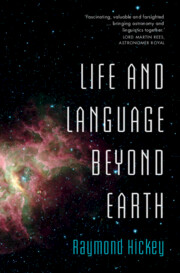Book contents
- Life and Language Beyond Earth
- Reviews
- Life and Language Beyond Earth
- Copyright page
- Contents
- Tables and Figures
- Preface
- How to Use This Book
- Part I Introduction
- Part II The Universe We Live In
- Part III Our Story on Earth
- Part IV The Runaway Brain
- Part V Language, Our Greatest Gift
- Part VI Life and Language, Here and Beyond
- 27 Preconditions for Life
- 28 What Might Exolife Be Like?
- 29 Looking for Signs of Life
- 30 The Issue of First Contact
- 31 Language Beyond Earth
- 32 How Human Language Arose
- 33 The Language of Exobeings
- 34 Looking Forward: The Basic Questions Again
- 35 Some Final Thoughts
- Book part
- Glossary
- Timelines
- Figure credits
- References
- Bibliography
- Index
28 - What Might Exolife Be Like?
from Part VI - Life and Language, Here and Beyond
Published online by Cambridge University Press: 16 September 2023
- Life and Language Beyond Earth
- Reviews
- Life and Language Beyond Earth
- Copyright page
- Contents
- Tables and Figures
- Preface
- How to Use This Book
- Part I Introduction
- Part II The Universe We Live In
- Part III Our Story on Earth
- Part IV The Runaway Brain
- Part V Language, Our Greatest Gift
- Part VI Life and Language, Here and Beyond
- 27 Preconditions for Life
- 28 What Might Exolife Be Like?
- 29 Looking for Signs of Life
- 30 The Issue of First Contact
- 31 Language Beyond Earth
- 32 How Human Language Arose
- 33 The Language of Exobeings
- 34 Looking Forward: The Basic Questions Again
- 35 Some Final Thoughts
- Book part
- Glossary
- Timelines
- Figure credits
- References
- Bibliography
- Index
Summary
What might exobeings really be like? To begin answering this question consider the deep history of our own evolution. Would the evolution of exobeings show the same key turning points we find in our own evolution? Would they develop complex multicellular life forms at an early stage and then move on to become vertebrates with a central nervous system controlled by a brain, allowing them to move around freely in their surroundings?1 Indeed, to what extent would what appear to us as preconditions, vertebrae and a skeleton to stabilise an animal’s body, be necessary on an exoplanet?
The degree of variability on an exoplanet could be similar to that found on Earth, with a certain range for cognitive ability (types of intelligence), personality, aspects of physical appearance such as size, eye and hair colour or shape of skeleton (observable in body build, hands, feet, arms, legs, etc.).
- Type
- Chapter
- Information
- Life and Language Beyond Earth , pp. 448 - 471Publisher: Cambridge University PressPrint publication year: 2023

